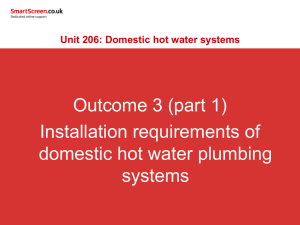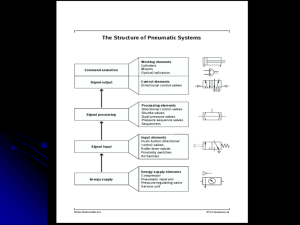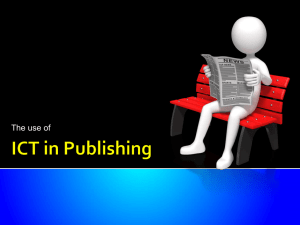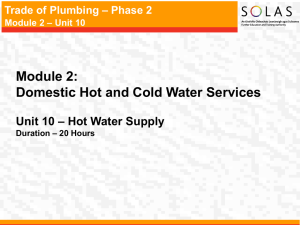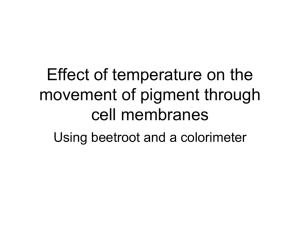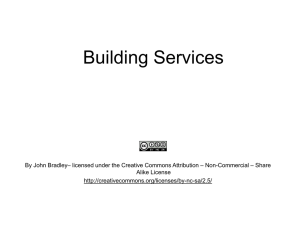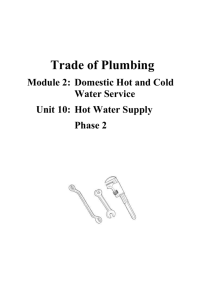6035_l2u206_ppt_outcome1_part_1
advertisement
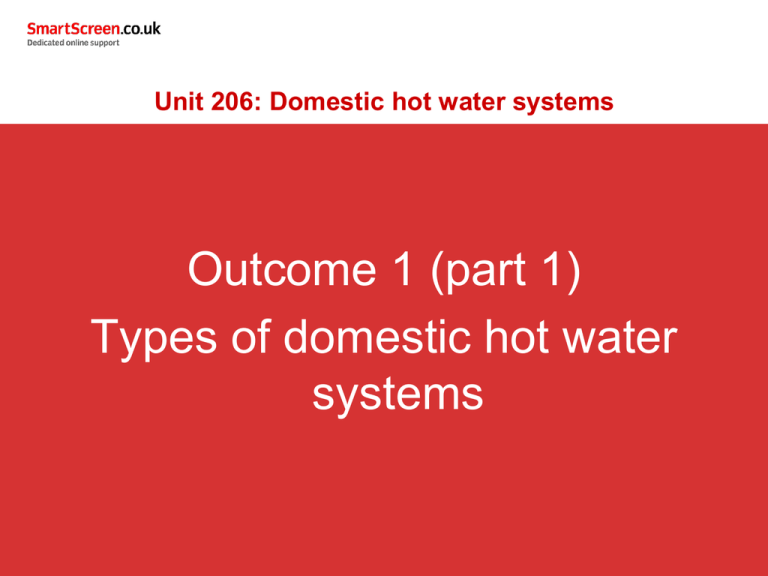
Unit 206: Domestic hot water systems Outcome 1 (part 1) Types of domestic hot water systems Types of systems Legislation The Water Regulations (1999) The Water Regulations Guide (WRAS) WRAS – Water Regulation Advisory Scheme Building Regulations Part G Directory of fittings (WRAS approved) Types of systems BS6700 – Design, installation, testing and maintenance of domestic hot and cold water systems BS8000 pt15 – Workmanship on building sites (code of practice for hot and cold water services) Types of systems Manufacturers’ instructions These will outline installation requirements, maintenance and servicing requirements and fault diagnosis, and list spare parts. They will also list commissioning details, such as flow rates and maximum temperatures for appliances. These must be followed at all times. Types of systems Types of systems Hot water: Centralised: Localised: Stored: Instantaneous: Water heated to a specific temperature for domestic use. Water is heated and/or stored centrally in the building and is distributed from that point to all the hot water outlets. Water is heated and/or stored locally to one specific draw-off point area. A cylinder of water is heated to temperature before being distributed to the hot water outlets. Water is heated on demand when hot water outlets are opened. Types of systems Centralised – stored hot water This is commonly used in a domestic property and uses a hot water cylinder, centrally located in an airing cupboard, which is heated by a boiler (or immersion) and distributes the hot water through the pipework system. Centralised – instantaneous hot water This is commonly used in smaller domestic properties and uses a combination boiler, which heats water on demand and distributes the hot water through the pipework system. Types of systems Centralised open vented indirect gravity system. This system is not installed today but is commonly found in older properties. The primary flow and return from the boiler relies on convection to transfer heat from the boiler to the cylinder. Types of systems Centralised open vented indirect pumped primaries. This system is commonly installed today. The primary flow and return from the boiler transfers heat from the boiler to the cylinder by the use of a pump or circulator through the coil. Types of systems The Feed & Expansion feeds the primary circuit – boiler, cylinder and F&E. The CWSC feeds the secondary circuit – hot water distribution. Types of systems These systems require: • Boiler • Primary flow and return pipes • Heat exchanger coil • Hot water cylinder • Cold water storage cylinder • Feed and expansion cistern • Open vent pipe • Cold feed pipe • Hot distribution pipe Make sure you can identify these components and describe their functions. Types of systems Direct hot water cylinder using a boiler. In this system there is no heat exchanger coil in the cylinder. The boiler heats the water that directly comes out of the draw off points. Types of systems Direct hot water cylinder using electric immersion heaters. In this system there is no heat exchanger coil, instead it uses two immersion heaters. They heat the water that directly comes out of the draw-off points. Types of systems Open vented systems These systems are low pressure systems relying on the head height of the CWSC to give the system pressure. They also contain a vent pipe, from the hot water cylinder which terminates over the cold water storage cistern. This allows the system to run a atmospheric pressure. The vent also allows air out of the system when it is filled, and allows air in the system when it is drained down. The primary function of the vent is to act as a safety relief when the system is operational: •Expansion and contraction on heating and cooling •Overheating on control failure Types of systems Open vented systems BS6700 recommends that the capacity of the CWSC feeding a hot water cylinder should be at least the capacity of the cylinder. If the CWSC feeds hot and cold, the minimum size is 230 litres. If the CWSC feeds just the hot system, the minimum size is 115 litres. Types of systems Important points: • Minimum size of vent pipe is 22mm • No valve allowed on vent pipe • Hot water distribution should rise slightly from the cylinder and should be at least 450mm long before the vent pipe connection (one pipe or parasitic circulation) • Cold feed should be sized according to BS6700. It also allows for expansion when the cylinder is heated • CWSC needs to be as high as possible for head pressure. • Cold feed pipe only goes to the cylinder and has a DOV at the lowest point As BS6700 states, no valves should be placed on the route of the vent pipe. If found, they need to be removed. Types of systems Direct or indirect open vented system In a direct system the hot water cylinder does not have any form of heat exchanger or coil. In older systems the water was heated directly by the boiler; in more modern systems the water is heated by immersion heaters. Types of systems Direct or indirect open vented system In an indirect system the hot water cylinder has an internal coil, which acts as the heat exchanger to heat the stored water. These cylinders normally have a back-up immersion. Types of systems Cylinders Coil Indirect double feed No coil (immersion) Direct Chamber Indirect single feed Types of systems The primary F&R pipework is normally 22mm unless it is from a solid fuel boiler, which would need 28mm pipework. Under part L the heat-up time Is now 25 minutes. High heat recovery cylinders will heat up in 10 minutes. Cylinder thermostat is positioned one-third of way up cylinder. Types of systems Under BS6700: • The minimum size of the open vent is 22mm • The open vent should not have any valves on it • There should be a minimum distance of 450mm from the exit of the cylinder to the open vent tee to stop one pipe circulation • The primary function of the open vent is to act as a safety relief valve in case of overheating • On the cold feed from the CWSC to the hot water cylinder, there should be a fullway gate valve installed • The minimum size of the cold feed is 22mm Types of systems Cylinder support When installed, cylinders should be placed on two pieces of wood or a purpose built vented stand, to prevent condensation forming on the base of the cylinder dome, thus affecting the floor. Types of systems These systems are called double feed systems. There are two cisterns in the loft area: • The larger CWSC feeds down to the hot water cylinder as hot water is drawn off • The smaller F&E cistern feeds down to the primaries and tops them up with water as required

